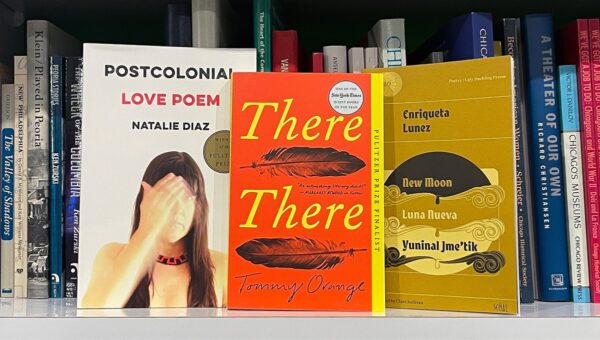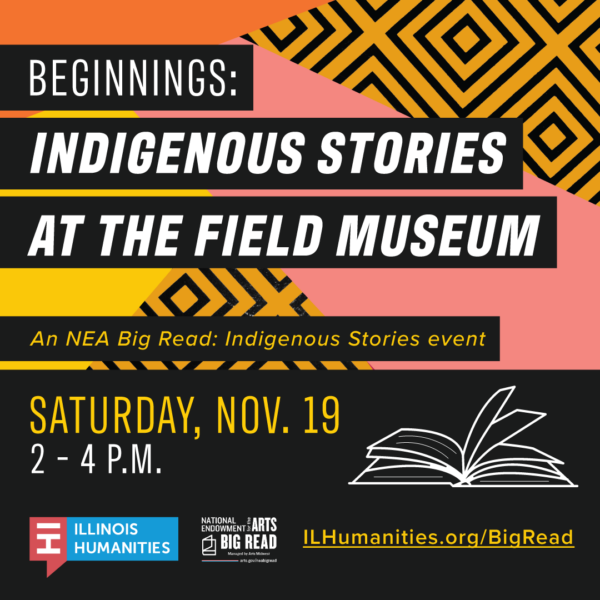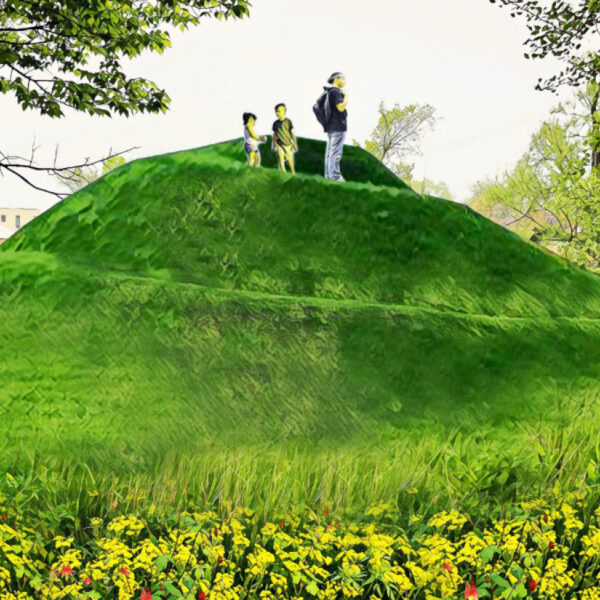I am thrilled to be able to tell you a bit about this year’s NEA Big Read: Indigenous Stories, which is only one expression of Illinois Humanities’ commitment to programs and actions that support Indigenous rights and cultural equity. We invite you to join us as we explore diverse Native voices and experiences in North America through reading groups, public conversations, and hands-on workshops.
All of these points of engagement are meant to remind us that our rural and urban landscapes preserve essential stories, and that – every single day — Native people are living, creating, and advocating for a more equitable future.

As someone who is not Native and grew up in Chicago’s suburbs in the 1980s, my education around what it meant to be Indigenous was very limited. You may have had a similar experience. I knew – or thought I did – that American Indians once lived where I did, that they traveled along the Des Plaines River, and that the name of our state had something to do with a Native word. Sometimes our history books would mention American Indians, but never in ways that felt three-dimensional and real. Not until I was an adult did I begin to realize my terrible ignorance. It goes to show that when people are marginalized in our schoolbooks and in our everyday experience, our ideas and thoughts are also constrained.
The NEA Big Read: Indigenous Stories is an opportunity for all of us to acknowledge what we don’t know, unlearn what we think we know, and initiate a process of learning anew. By reading and sharing together, we tap into the ineffable power that exists in story-telling and story-listening. Through these practices we begin to understand each other and soften the boundaries that may separate us.
Indigenous Stories centers the perspectives of Native people – from Tommy Orange’s There There to Natalie Diaz’s Postcolonial Love Poem and Enriqueta Lunez’s New Moon/Luna Nueva/Yuninal Jme’tik, from artist Monica Rickert-Bolter’s consultation on the Field Museum’s Native Truths exhibition to Bernadine Vigue’s experience of displacement and relocation. They challenge us to read closely, ask questions, and think hard about what it means to go about our days on occupied land.
 Some of us may be uncomfortable with what we read and hear. Maybe we are even uncomfortable with the words “occupied land.” I’d encourage you to lean into that discomfort and interrogate it. Where does it come from? How can you accept discomfort as a teacher rather than as an antagonist?
Some of us may be uncomfortable with what we read and hear. Maybe we are even uncomfortable with the words “occupied land.” I’d encourage you to lean into that discomfort and interrogate it. Where does it come from? How can you accept discomfort as a teacher rather than as an antagonist?
On November 19, Indigenous Stories will launch with a visit to the Field Museum’s exhibition Native Truths: Our Voices, Our Stories, followed by a public conversation in the museum’s Founders Room with three of the Native consultants who helped to develop the exhibition. This project marks an extraordinary effort by Native advocates and museum staff to re-examine how long-established institutions like the Field can better practice self-reflection, truth-telling, and revision in a changing world. As we honor Native American Heritage Month, the opportunity to be in community with Native leaders in this unique space is a perfect way to begin our learning together.
After the start of the new year, we will have the chance to participate in more hands-on learning experiences. At the Newberry Library, we will examine items from the Ayer Collection of American Indian and Indigenous Studies and ask questions about what it means to “collect” other people’s heritage, who “owns” historical artifacts, and what potential for transformation and reparation an archive can hold.
In late spring, we will meet at Horner Park on the Northwest Side of Chicago, where we will witness the reclamation of Native ancestral placemaking practices through the completion of a coiled earthwork mound by SANTIAGO X. You may even have the chance to install a Native plant on the mound. Stay tuned for more information about these events and a writing workshop in the coming months.

The NEA Big Read: Indigenous Stories would not happen without a small, but expert cadre of book group facilitators who lead our Long Overdue Book Groups. These facilitators are all alumni of Illinois Humanities’ The Odyssey Project/Proyecto Odisea and they are dedicated to tending to the long overdue conversations we all need to have.
While we encourage you to host your own book groups and offer a toolkit to help you do that, I cannot say enough about the care, joy, and skill our Long Overdue Book Group facilitators bring to our reading communities. Some of our groups meet via Zoom, so even if you are not in Chicagoland, you can still join them. (And, by the way, they meet year-round, not just during the Big Read!) Learn more here.
With enormous gratitude, I also want to acknowledge the central role our partners in this program continue to play in consulting us and giving shape to this year’s Big Read. They include Debra Yepa-Pappan (Center for Native Futures and Field Museum), Kim Vigue (Mitchell Museum of the American Indian), Kara Johnson (Newberry Library), and Chantal Healy (Chicago Public Art Group). I hope that the Big Read introduces you to the amazing work all of these people do in their own lives and institutions.
Join the NEA Big Read: Indigenous Stories by signing up for a book group, starting your own, and registering for a free public event at ILHumanities.org/BigRead.